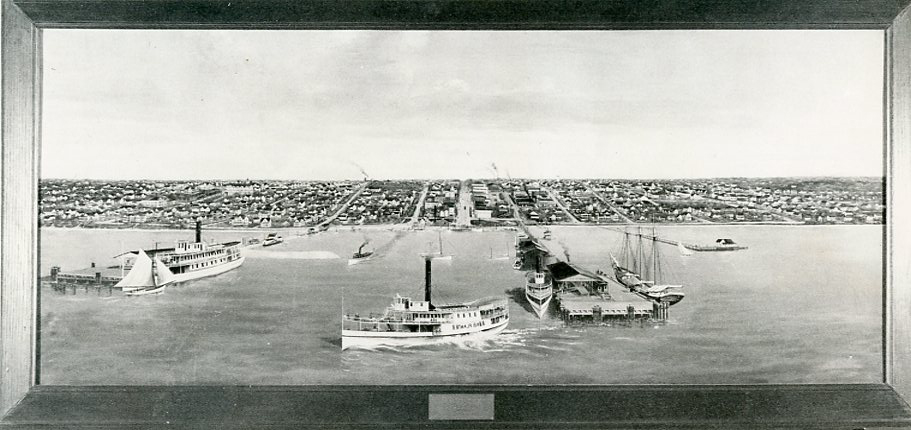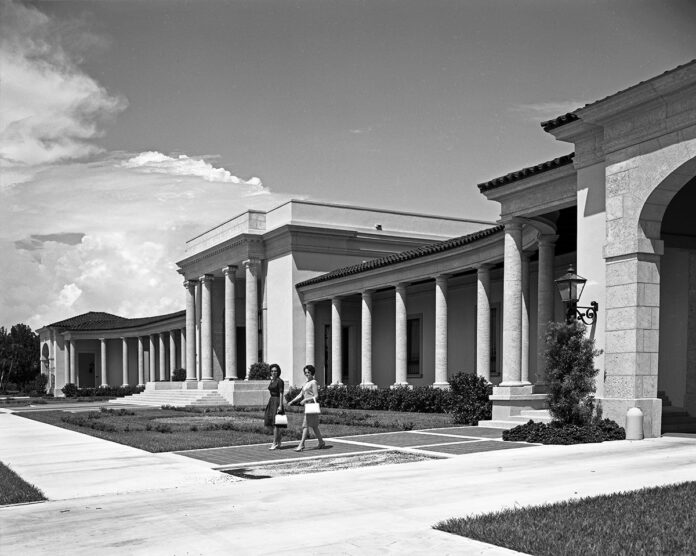As this month’s SHINE St. Petersburg Mural Festival reminds us, art thrives in St. Pete. In addition to our diverse array of public art, we have world-class museums, active independent galleries and artist markets. The depth and breadth of this current vibrancy sometimes invites comparison with the not-so-distant past, when some saw the city as a cultural and social wasteland. Those harsh recollections are not completely accurate; we’ve always had art. The city’s director of cultural affairs, Wayne Atherholt, may have said it best in a 2018 interview: “Even back in those early days … art was significant. It’s part of the city’s DNA.”

The early days: waterfront visions and mid-winter fairs
In 1903, the year of the city’s incorporation, William Straub, an artist and owner/editor of the St. Petersburg Times, painted an idyllic view of the waterfront as he imagined it could be. No doubt that vision helped a young city envision a waterfront park as a reality. Straub wasn’t alone in his interest in the arts. By 1908, at least two people offered instruction in drawing and painting: Miss Frances Williams, the former director of art for the Pennsylvania Chautauqua, and Mrs. Nellie R. Loehr, whose oil and watercolor work was on display in the window of the local optician’s office. Interest in the arts is also evident in a 1908 Times column boasting the city’s many offerings. The list included two theaters, three photography parlors, and two art stores, an impressive offering for a community of fewer than 4,000 people with just two banks and “only two undertakers.” The column also highlights the annual free 30-day Mid-Winter Fair. In the decade after 1900, the “immense” fair provided exhibition space as well as awards to Tampa Bay residents for “all products,” including artistic creations such as oil and watercolor paintings. Art stores, classes, and exhibitions show that the community clearly already valued creative endeavors. As St. Pete entered into its second decade as an incorporated city, a group of art lovers planted the roots for a more robust movement that still blossoms today.
Planting new roots: the Florida Winter Art School and the Art Club of St. Petersburg
In 1916, J. Liberty Tadd arrived in town, leased some land on present-day Beach Drive, and opened the Florida Winter Art School. Tadd died the next year, but the school continued under the direction of his widow, Margaret, and their daughter, Edith. Determined to further art and art appreciation, they also set out to organize an art club. Hoping for 30 interested people, they drew 90 responses to their initial inquiry. In December 1919, 75 people attended the first meeting of the new Art Club of St. Petersburg. Meeting at the Winter Art School, the Art Club’s purpose was “to aid in whatever may tend to stimulate and encourage an appreciation of art and a love of the beautiful in our city and community.”
The club was limited to white, middle-class professionals and their spouses. Within that circumscribed sphere, it was a rousing success, quickly growing into the largest art center south of Atlanta. It offered classes in drawing and painting, attracted top-tier local and international artists for exhibitions, and shone positive attention on the city. By the early 1920s, its popularity prompted the Times to launch a regular “Art & Artists” column. Its influence went beyond established art lovers.

The club also established a pattern of civic participation that established the arts as a vital part of the community. Members gave lectures at local schools, groups of children regularly visited art exhibitions, and the club offered numerous free exhibits each season. Its influence contributed to the decision to add an art department to the public schools, the first district in Florida to do so. The Art Club’s impact did not go unnoticed. In 1924 the American Art Magazine lavished compliments on it “as the real force for the extension and growth of the art phase in St. Petersburg.” It would remain a significant force for decades, even as the art community grew and diversified.
New Blossoms: a museum and a new community arts center
In 1961, the Art Club gave up the dilapidated city-owned building on Beach Drive. Soon afterward, Margaret Acheson Stuart moved in and launched a plan to open the city’s first museum devoted to the exhibition of fine art. In 1965, the Museum of Fine Arts fulfilled that dream adjacent to the site of Art Club’s former home. Meanwhile, the Art Club splintered into separate organizations as members’ goals shifted. Reunification in the early 1970s created the Art Center Association, now known as the Morean Arts Center. It has stayed true to its original mission to provide a true community arts center with exhibit space, classrooms, and working studios. Today the Morean and the MFA are just two of many locations dedicated to art. Their continued presence as well as our picturesque waterfront remind us that St. Pete has always valued art. It’s in our DNA.
Resources available on request. They The Artists of Old Florida by Alfred R. Frankel and Morean Arts Center: Celebrating 100 years of Art & Community by Clint Page.



